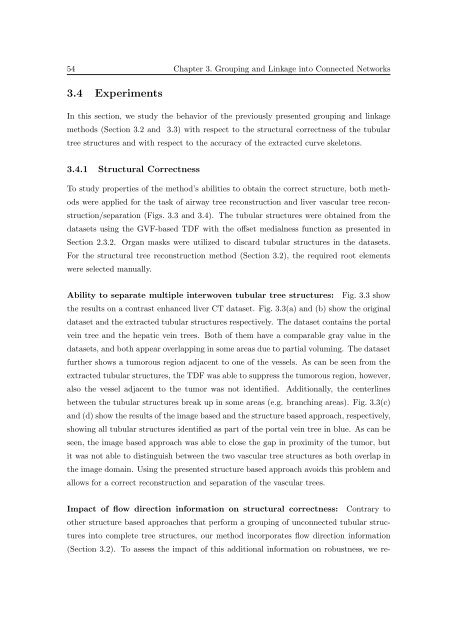Segmentation of 3D Tubular Tree Structures in Medical Images ...
Segmentation of 3D Tubular Tree Structures in Medical Images ...
Segmentation of 3D Tubular Tree Structures in Medical Images ...
You also want an ePaper? Increase the reach of your titles
YUMPU automatically turns print PDFs into web optimized ePapers that Google loves.
54 Chapter 3. Group<strong>in</strong>g and L<strong>in</strong>kage <strong>in</strong>to Connected Networks<br />
3.4 Experiments<br />
In this section, we study the behavior <strong>of</strong> the previously presented group<strong>in</strong>g and l<strong>in</strong>kage<br />
methods (Section 3.2 and 3.3) with respect to the structural correctness <strong>of</strong> the tubular<br />
tree structures and with respect to the accuracy <strong>of</strong> the extracted curve skeletons.<br />
3.4.1 Structural Correctness<br />
To study properties <strong>of</strong> the method’s abilities to obta<strong>in</strong> the correct structure, both methods<br />
were applied for the task <strong>of</strong> airway tree reconstruction and liver vascular tree reconstruction/separation<br />
(Figs. 3.3 and 3.4). The tubular structures were obta<strong>in</strong>ed from the<br />
datasets us<strong>in</strong>g the GVF-based TDF with the <strong>of</strong>fset medialness function as presented <strong>in</strong><br />
Section 2.3.2. Organ masks were utilized to discard tubular structures <strong>in</strong> the datasets.<br />
For the structural tree reconstruction method (Section 3.2), the required root elements<br />
were selected manually.<br />
Ability to separate multiple <strong>in</strong>terwoven tubular tree structures: Fig. 3.3 show<br />
the results on a contrast enhanced liver CT dataset. Fig. 3.3(a) and (b) show the orig<strong>in</strong>al<br />
dataset and the extracted tubular structures respectively. The dataset conta<strong>in</strong>s the portal<br />
ve<strong>in</strong> tree and the hepatic ve<strong>in</strong> trees. Both <strong>of</strong> them have a comparable gray value <strong>in</strong> the<br />
datasets, and both appear overlapp<strong>in</strong>g <strong>in</strong> some areas due to partial volum<strong>in</strong>g. The dataset<br />
further shows a tumorous region adjacent to one <strong>of</strong> the vessels. As can be seen from the<br />
extracted tubular structures, the TDF was able to suppress the tumorous region, however,<br />
also the vessel adjacent to the tumor was not identified. Additionally, the centerl<strong>in</strong>es<br />
between the tubular structures break up <strong>in</strong> some areas (e.g. branch<strong>in</strong>g areas). Fig. 3.3(c)<br />
and (d) show the results <strong>of</strong> the image based and the structure based approach, respectively,<br />
show<strong>in</strong>g all tubular structures identified as part <strong>of</strong> the portal ve<strong>in</strong> tree <strong>in</strong> blue. As can be<br />
seen, the image based approach was able to close the gap <strong>in</strong> proximity <strong>of</strong> the tumor, but<br />
it was not able to dist<strong>in</strong>guish between the two vascular tree structures as both overlap <strong>in</strong><br />
the image doma<strong>in</strong>. Us<strong>in</strong>g the presented structure based approach avoids this problem and<br />
allows for a correct reconstruction and separation <strong>of</strong> the vascular trees.<br />
Impact <strong>of</strong> flow direction <strong>in</strong>formation on structural correctness: Contrary to<br />
other structure based approaches that perform a group<strong>in</strong>g <strong>of</strong> unconnected tubular structures<br />
<strong>in</strong>to complete tree structures, our method <strong>in</strong>corporates flow direction <strong>in</strong>formation<br />
(Section 3.2). To assess the impact <strong>of</strong> this additional <strong>in</strong>formation on robustness, we re-















